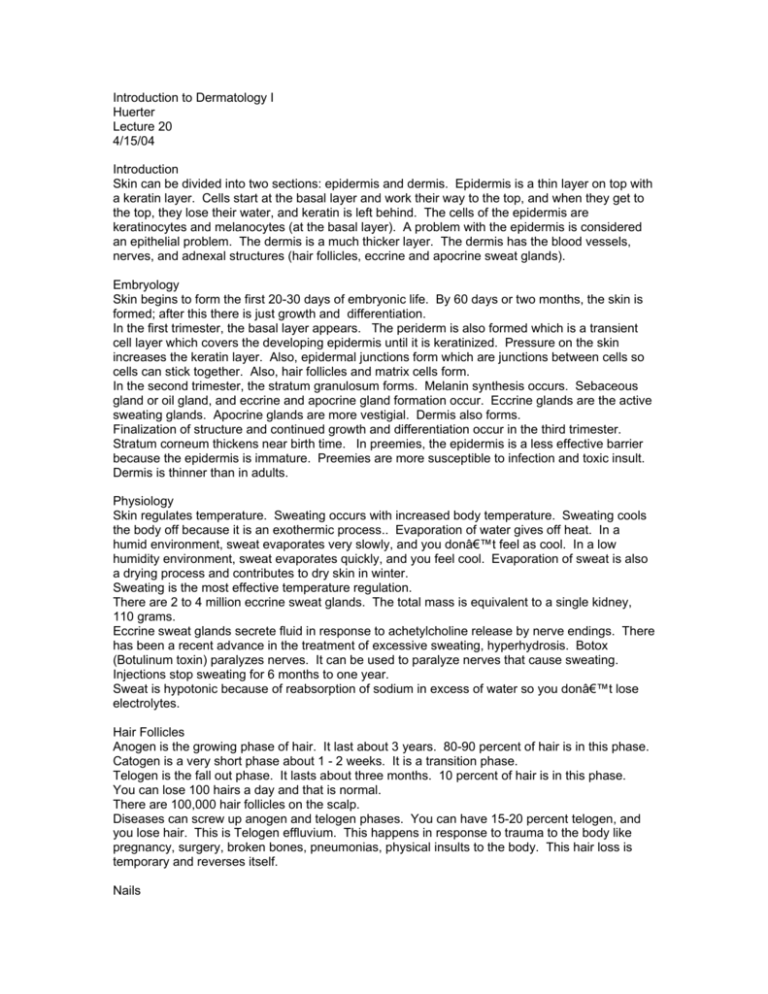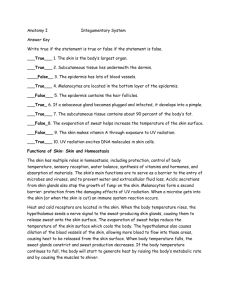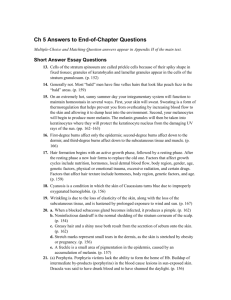Lecture 20
advertisement

Introduction to Dermatology I Huerter Lecture 20 4/15/04 Introduction Skin can be divided into two sections: epidermis and dermis. Epidermis is a thin layer on top with a keratin layer. Cells start at the basal layer and work their way to the top, and when they get to the top, they lose their water, and keratin is left behind. The cells of the epidermis are keratinocytes and melanocytes (at the basal layer). A problem with the epidermis is considered an epithelial problem. The dermis is a much thicker layer. The dermis has the blood vessels, nerves, and adnexal structures (hair follicles, eccrine and apocrine sweat glands). Embryology Skin begins to form the first 20-30 days of embryonic life. By 60 days or two months, the skin is formed; after this there is just growth and differentiation. In the first trimester, the basal layer appears. The periderm is also formed which is a transient cell layer which covers the developing epidermis until it is keratinized. Pressure on the skin increases the keratin layer. Also, epidermal junctions form which are junctions between cells so cells can stick together. Also, hair follicles and matrix cells form. In the second trimester, the stratum granulosum forms. Melanin synthesis occurs. Sebaceous gland or oil gland, and eccrine and apocrine gland formation occur. Eccrine glands are the active sweating glands. Apocrine glands are more vestigial. Dermis also forms. Finalization of structure and continued growth and differentiation occur in the third trimester. Stratum corneum thickens near birth time. In preemies, the epidermis is a less effective barrier because the epidermis is immature. Preemies are more susceptible to infection and toxic insult. Dermis is thinner than in adults. Physiology Skin regulates temperature. Sweating occurs with increased body temperature. Sweating cools the body off because it is an exothermic process.. Evaporation of water gives off heat. In a humid environment, sweat evaporates very slowly, and you don’t feel as cool. In a low humidity environment, sweat evaporates quickly, and you feel cool. Evaporation of sweat is also a drying process and contributes to dry skin in winter. Sweating is the most effective temperature regulation. There are 2 to 4 million eccrine sweat glands. The total mass is equivalent to a single kidney, 110 grams. Eccrine sweat glands secrete fluid in response to achetylcholine release by nerve endings. There has been a recent advance in the treatment of excessive sweating, hyperhydrosis. Botox (Botulinum toxin) paralyzes nerves. It can be used to paralyze nerves that cause sweating. Injections stop sweating for 6 months to one year. Sweat is hypotonic because of reabsorption of sodium in excess of water so you don’t lose electrolytes. Hair Follicles Anogen is the growing phase of hair. It last about 3 years. 80-90 percent of hair is in this phase. Catogen is a very short phase about 1 - 2 weeks. It is a transition phase. Telogen is the fall out phase. It lasts about three months. 10 percent of hair is in this phase. You can lose 100 hairs a day and that is normal. There are 100,000 hair follicles on the scalp. Diseases can screw up anogen and telogen phases. You can have 15-20 percent telogen, and you lose hair. This is Telogen effluvium. This happens in response to trauma to the body like pregnancy, surgery, broken bones, pneumonias, physical insults to the body. This hair loss is temporary and reverses itself. Nails The matrix is the pink crescent. The cells here make the nail. The area behind the matrix is the proximal nail fold area. If the matrix cells are damaged, the nail is messed up for life. Fungal nails are called onychomycosis. A dermatophyte infection gets into the matrix and becomes incorporated into the nail plate. The nail bed is the area underneath the plate. The hypernichium is the angle between the nail at the tip and the skin. The nail plate grows 0.1 mm per day. Skin is an Organ of Protection The epidermis protects against water loss by lipids in the stratum corneum. The stratum corneum impedes absorption of toxic materials, particularly polar agents. Poison ivy abstract is nonpolar and tends to get through. The stratum corneum protects against invasion by microorganisms. Skin protects against ultraviolet radiation by protein layer stratum corneum.. The melanin produced by melanocytes blocks UV light. Most sunlight is UVB which burns you. There is also some UVA. UVC is the shortest wavelength and is blocked by the ozone layer. Intact ozone protects against UVC. In places where ozone is not intact (Southern Hemisphere), there is more skin cancer. There are collagen and elastin fibers in the dermis. Collagen fibers cross link. Collagen breaks down when it loses its cross links. UV that gets into dermis breaks up and fragments collagen fibers. The cross links break down, and the skin sags and wrinkles. Skin protects against mechanical damage using subcutaneous fat. Immune Function of Skin Lymphocytes are the primary mediator of immune system. Langerhans cells in the epidermis are antigen processing cells. They present antigens to lymphocytes. Sunburns chase away Langerhans cells. Cells in burn area exposed to UV light can become cancerous. Langerhans cells aren’t there to get rid of them. Melanoma can gain a foot hold. Burn recovery is a risk factor for melanoma. Diagnostic Tools KOH Exam = Superficial fungal infections (dermatophytes; tinea pedis); Scabies (mite) Woods Lamp = blacklight; certain dermatoses fluoresce; nonspecific; fungal infections (tinea; dermatophyte); good for distinguishing differences in pigmentation; erythrasma= bacterial infection caused by corynebacterium minitissimum and fluoresces corral red color from porphyrin production Tzanck Prep = diagnose viral infections; herpes simplex and herpes zoster which produce water blisters (vesicles); these have multinucleated giant cells Culture = any type of infection; viral, bacteria, fungus Skin Biopsy = do it if it will affect the way you will treat the patient; for any kind of growth / cancer suspicion; helpful for ruling stuff out; Punch = cookie cutter = good for depth and straight edges and margins; also for flat areas; Shave = good for rounded papules; make sure to communicate with the pathologist









